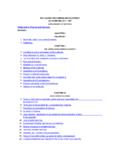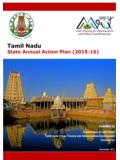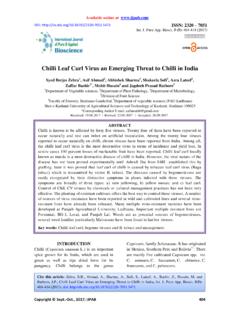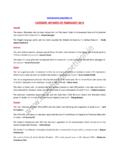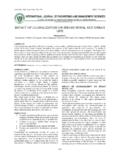Transcription of Directorate of Municipal Administration, Karnataka
1 Page 1 of 3 eGovernments Foundation #18/2A, GRS Towers, Second Floor, Above Spencer s Sarjapur Road, Bangalore 560 102, Karnataka , India Directorate of Municipal Administration, Karnataka A success story The Karnataka state government in 2005 initiated an Asian Development Bank (ADB) funded state-wide reform initiative covering the largest 49 Municipal bodies in the state. Named as the Nirmala Nagara Project (referred to as NN), the objective was to introduce reforms across these Municipal bodies. These reforms were further extended to cover another 164 ULBs under the World Bank funded Karnataka Municipal Reforms Project.
2 One of the key components of this initiative was the e-governance component. To implement the initiative, eGovernments Foundation was chosen to develop a state of art solution leveraging web based architecture and centralized deployment. Targeted Beneficiaries Citizens of all 213 ULBs Business owners in the ULBs Department users across various layers in the ULBs viz., Commissioner, City engineer, HODs, Revenue Officials, Elected Representatives etc. Objectives of the Programme The program was meant to provide efficient services to citizens, administrators and corporators by implementing e-governance solutions. The objectives of the programme were to Increase efficiency and productivity of the ULB Integrate data and services of various departments Re-engineer processes for better service delivery to the beneficiaries Move from process accountability to productivity accountability and from transactional to transformative governance Reduce delays and ensure promptness in delivery of services through computerization Improve administrative processes by cutting cost and managing performance Empowering officials and decision makers with accurate information using the data captured Identify source of problems within the system in an effort to carry out prompt
3 Remedial activities Page 2 of 3 eGovernments Foundation #18/2A, GRS Towers, Second Floor, Above Spencer s Sarjapur Road, Bangalore 560 102, Karnataka , India Provide a single window delivery mechanism for services and information to citizens Provide integrated and simplified services to citizens on any time, anywhere basis Promote people centric administration Establish a good dialogue between the citizens and the ULB Scope of Implementation Development and roll out of o Property tax management system integrated with GIS o Fund-based double-entry Accrual Accounting and Budgeting system o Public grievance and redressal system o Birth and death registration system Major Implementation Challenges 1.
4 Getting a buy-in from the administrative heads of the ULBs, creating in them a sense of ownership and making them appreciate that the changes were systemic and not ad-hoc 2. A programme of this scale that involved multi-year, multi-disciplinary, state-wide implementation was difficult to monitor for progress. To overcome this, a project monitoring mechanism was devised whereby each Municipal body reported their weekly progress on a pre-defined set of parameters. 3. Centralised implementation of the software with the Municipal bodies accessing the systems over the internet meant that the municipalities spread across the state had to be provided with high-speed internet connectivity.
5 This was resolved by having a Karnataka State wide area network that ensured a high speed dedicated lease line for the ULBs. 4. The centralized solution had to accommodate ULB specific needs and data isolation. Governments Foundation ensured that the solution architecture provided isolated data for each ULB and standardised business logic implementation across the state. This significantly improved the acceptance of the solution by ULBs. 5. Capacity Building and Change Management Achievements of the Programme 1. Successful implementation of a Public Grievance and Redressal module covering all the Municipal bodies. 2. Successful implementation of a fund-based double-entry accrual accounting system in all the Municipal bodies.
6 Publishing opening balances and balance sheets from the system is a major achievement given the historically poor state of accounting practices in the ULBs. 3. Adoption of process and data standards across the state. Starting with the largest corporations and extending to the smallest town panchayat, the processes and data records have been standardized. 4. The creation of the Karnataka Municipal Data Society (KMDS) as a sustainable institutional structure that ensured the systems ran and evolved on a continuous basis. This helps set the Municipal bodies on a path of continuous improvement. 5. A centralized software platform delivered over the internet has dramatically reduced the capital costs (hardware, software) and operational costs (in terms of data centre maintenance, personnel costs).
7 The latter is especially significant given the difficulty in finding qualified technical support in the smaller municipalities . Page 3 of 3 eGovernments Foundation #18/2A, GRS Towers, Second Floor, Above Spencer s Sarjapur Road, Bangalore 560 102, Karnataka , India Impact of the Programme 1. Property Tax: The largest GIS based Property Tax implementation in the country covering more than million land parcels. 30% to 200% increase in revenues. Over 50% increase in number of assessed properties. 2. Financial Accounting: Double entry accrual based system functional since 2007. More than 180 municipalities have published their balance sheets from the system.
8 3. Grievance Redressal: Over million grievances registered in the system with 96% redressal rates. 4. Birth & Death Registration: million records registered. million Certificates issued from the system. Time taken to issue certificate reduced from 2-3 days to less than 15 minutes. Increased citizen satisfaction.

